This is our step-by-step guide on how to dehydrate brown rice. Dehydrating brown rice in your food dehydrator is easy to do. Dehydrated rice hydrates quickly and is perfect for camping and backpacking meals.
Over half the world’s population consumes rice at each meal. Rice is an inexpensive way to round out the menu.
Use fat-free broths to add more flavor to your next dehydrated rice project. We have used chicken, beef, pork, seafood, and vegetable broths, all with good results.
We decided to give brown rice its own how-to dehydrate page because storage requirements are different from other types of rice.
So, let’s get started dehydrating some brown rice.
Table of Contents
- How to Dehydrate Brown Rice
- Tools and Supplies Needed to Dehydrate Brown Rice
- Step 1. The Process to Dehydrate Brown Rice
- Step 2. Preparing for Dehydrator for Dehydrating Brown Rice
- Step 3. Dehydrating Brown Rice
- Step 4. When is the Dehydrated Brown Rice Done
- Step 5. Equalizing and Conditioning of Dehydrated Brown Rice
- Step 6. Storing the Dehydrated Brown Rice
- Hydration
- Weights, Measures, and Serving Sizes
- Dehydrated Brown Rice Nutrition Information
- Insider Tips
How to Dehydrate Brown Rice
Rice of all types forms the basis of many meals. So make a lot of dehydrated rice as it will disappear fast when making those camping meals.
Making the rice ahead of time allows you to have “instant” rice where water and cooking resources may be scarce or you don’t have the time to heat and cook.
Why not use quick-cooking store-bought flavored rice blends? You certainly can; however, take the time to read the food label ingredients list first. Many contain added salt, sugar, flavor enhancers, and other preservatives you may not want. Others might be labeled as containing bioengineered food ingredients, meaning ingredients not naturally found in nature. So we choose to make our own blends.
All you need to dehydrate brown rice is a good quality food dehydrator. We use the Nesco food dehydrators. You can check out our food dehydrator guide to learn why we think Nesco offers the best bang for the buck. We believe this is the best food dehydrator for our long-term food storage needs.
Tools and Supplies Needed to Dehydrate Brown Rice
- Food dehydrator
- Removable fruit roll sheet inserts for the dehydrator trays
- Standard kitchen tools, including cutting boards, chef’s knife, spatula, strainers, etc.
- Clear canning jars with tight-fitting lids
- Desiccant packets
- Wide-mouth canning jar funnel
- Brown rice
- Low-fat, low-sodium broth or stock
Step 1. The Process to Dehydrate Brown Rice
Cook the desired amount of brown rice following the directions on the bag … with these caveats.
Rinse the brown rice using a wire mesh strainer. Rinsing rice before cooking washes away surface starch and dust. The surface starch makes it harder to separate the cooked rice when loading it onto the dehydrator trays.
We’re also inspecting the brown rice and removing anything that shouldn’t be there. Despite the use of modern cleaning equipment, it is not always possible to remove all foreign materials. Sift and remove any foreign materials as you rinse the rice.
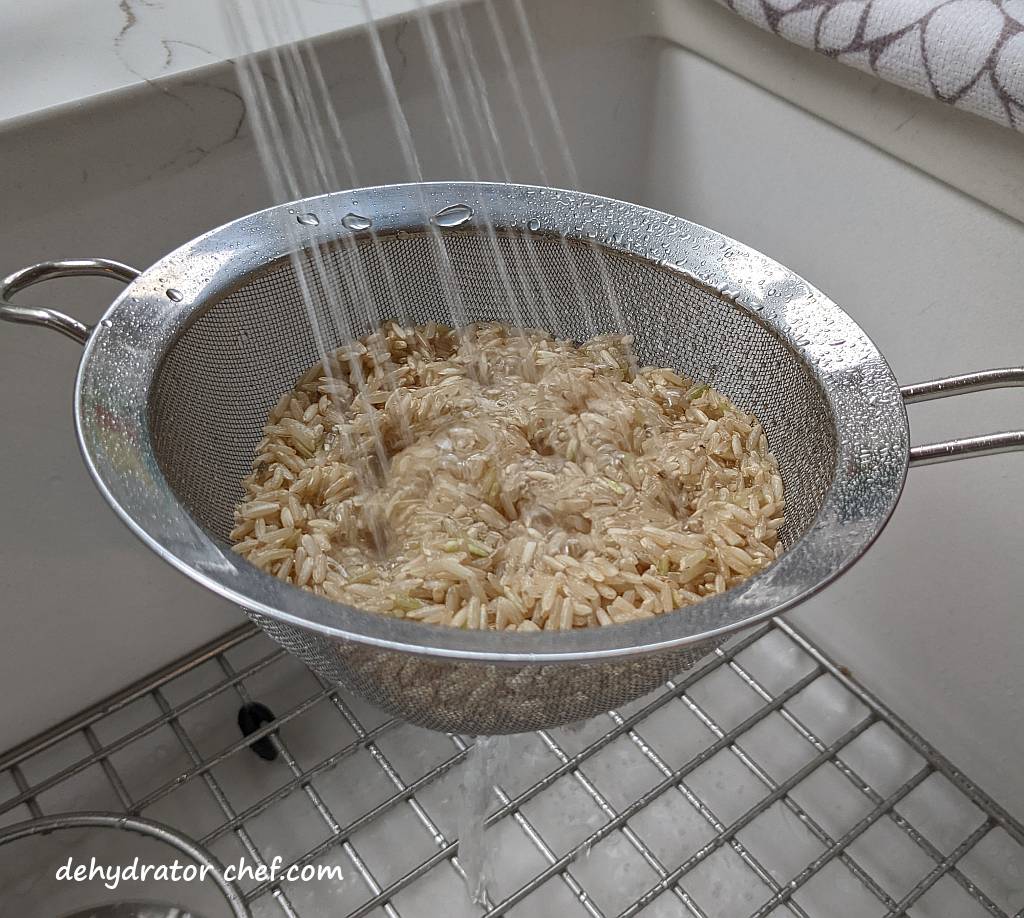
Rinse the brown rice before cooking. Place whatever quantity of rice you are cooking in a mesh strainer and rinse under running water until it runs clear. Doing this will remove some, but not all, of the surface starch and reduce the stickiness of the rice grains.
Consider substituting a low-fat or fat-free broth instead of water for more flavor in the boiling liquid. Other flavor options include vinegar, fish sauce, soy sauce, tamari sauce, Worcestershire sauce, or miso paste.
The usual method of cooking brown rice is a ratio of 1 cup of rice to about 2-1/2 cups of liquid, which will make about 3 cups of cooked rice or about 3 servings. My method for making brown rice is 2 cups of brown rice to 5 cups of liquid for about 7 cups of cooked rice, which will fill up four of my Nesco 13.5-inch round dehydrator trays.
Once the brown rice has cooked to the desired doneness, about 45 minutes, drain off any remaining liquid. Finally, put the brown rice back into the empty cooking pot, cover it, and let steam and rest for another 10 to 15 minutes.
Step 2. Preparing for Dehydrator for Dehydrating Brown Rice
We will use these removable Nesco fruit roll sheet inserts on our food dehydrator for today’s project. They have over 3000 customer reviews with an average rating of 4.5 stars out of 5, which is evidence of a great product. Check out other Nesco food dehydrator products here.
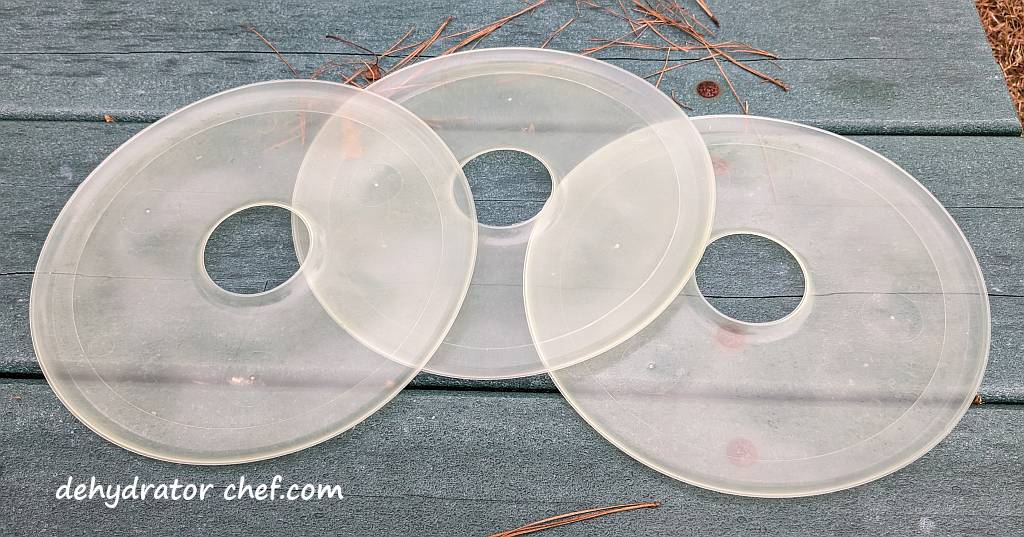
Evenly spread out and create a thin layer of the cooked brown rice onto the fruit roll sheets for even drying. A spatula works well here. If it’s too crowded, prepare another dehydrator tray.

The Nesco 13.5-inch round dehydrator tray has close to 119 square inches or .8 square feet of surface area for drying.
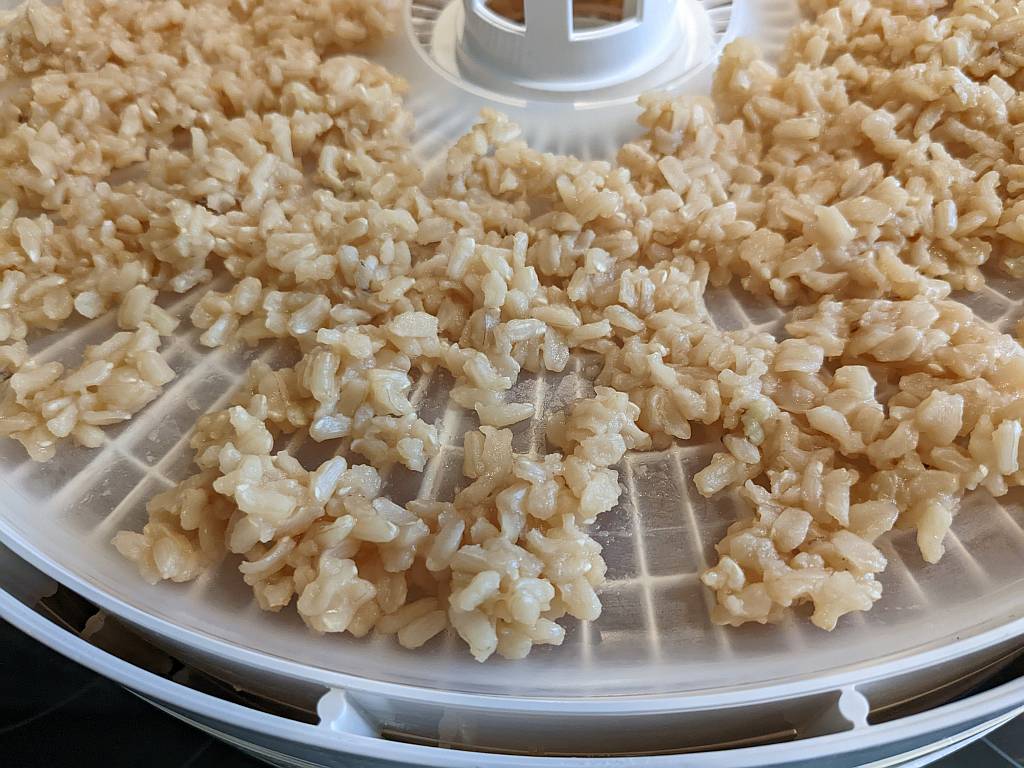
Step 3. Dehydrating Brown Rice
To save some time, you can start dehydrating the brown rice by setting the initial drying temperature to 160 °F (71 °C) for no more than one hour. Then dial the temperature back to 135 °F (57 °C) until dry, approximately 18 to 24 hours. Drying times are variable and dependent on your food dehydrator, the ambient temperature and humidity, the number of dehydrator trays, the size of food items, and how crowded you fill your dehydrator trays.
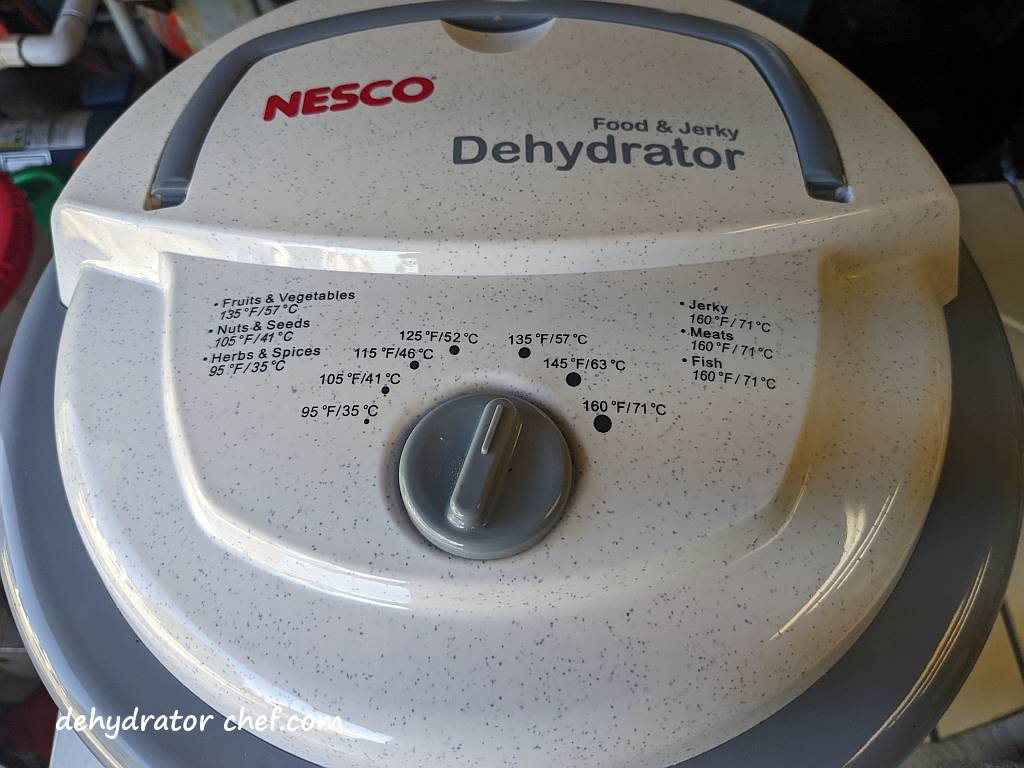
Every hour or so, break up the larger rice clumps and move the rice around a bit on the fruit roll sheets for a better product. Otherwise, the rice grains tend to stick to each other and will take longer to dehydrate.
The dehydrating rice will tend to shrink and break apart into sections. Pick up and examine the rice pieces, both top and bottom, looking for any sign of moisture or areas of undried rice. If seen, just let it dehydrate for another few hours and check again.
Step 4. When is the Dehydrated Brown Rice Done
Start checking for doneness in 18 hours. Brown rice takes 18 to 24 hours to fully dehydrate at 135 °F (57 °C), depending on ambient temperatures and humidity.
Drying times depend on your food dehydrator, the ambient temperature and humidity, the number of dehydrator trays, the size of food items, and how crowded you fill your dehydrator trays. Refer to your dehydrator owner’s manual for recommended temperatures and times for dehydrating specific foods. Remember to use drying times as a guide.

Fully dried, the brown rice grains will be hard and dry. The sections easily break apart into smaller fragments. The fragments are broken apart and checked for dryness.
Step 5. Equalizing and Conditioning of Dehydrated Brown Rice
We always recommend letting food items cool completely after they have finished dehydrating and before packing them into an airtight storage container for equalizing and conditioning. Warm food may cause sweating which could provide enough moisture for mold to grow.
It does not take long for dehydrated food items to start hydrating from ambient household humidity. Do not leave dehydrated food items exposed to the elements any longer than necessary because of the increased risk of mold growth.
After a short cooling period, pack the dehydrated brown rice into a clean, dry, insect-proof, and air-tight storage container. We use pint-size and quart-size canning jars to condition brown rice. Since the canning jars are clear, it’s easy to see what’s inside. Fill the jars at most 2/3 to 3/4 full, leaving some headspace.
Headspace is the distance between the food surface and the lid’s underside. Its purpose is to provide ample space for the dehydrated food product to slide and tumble when shaken and rotated to expose any evidence of clumping or sticking.
A quality stainless steel or plastic canning jar funnel makes the messy job of getting dehydrated foods off the dehydrator tray removable inserts and into the canning jars an easy task. Take a minute or two and check them out here on Amazon.
When the dehydrated rice is removed from the dehydrator, the remaining moisture may not be distributed equally among the rice grains because of their location and position in the dehydrator. Equalizing and conditioning is a process for freshly dehydrated foods that ensures any residual moisture remaining in any piece is spread or equalized among all the other pieces in the batch. Let the dehydrated rice equalize and condition in the storage container for 7 to 10 days.
Every day, check the jar for moisture. Roll the jar contents around and note any clumping or sticking. If seen, put the contents back on the dehydrator for several more hours. Since canning jars are clear, it’s easy to see what’s inside.
If you notice any mold at all, even the smallest bit, throw it all out. What you see are the mold spores finally blooming enough to make them visible. But there are more, even tinier mold spores in the rest of your jar that make your dehydrated food inedible. Toss it out and start another batch.
Step 6. Storing the Dehydrated Brown Rice
Use an appropriately sized mason jar for storage. The dehydrated brown rice might keep up to 6 or 9 months. Exactly how long depends upon your pantry storage conditions.
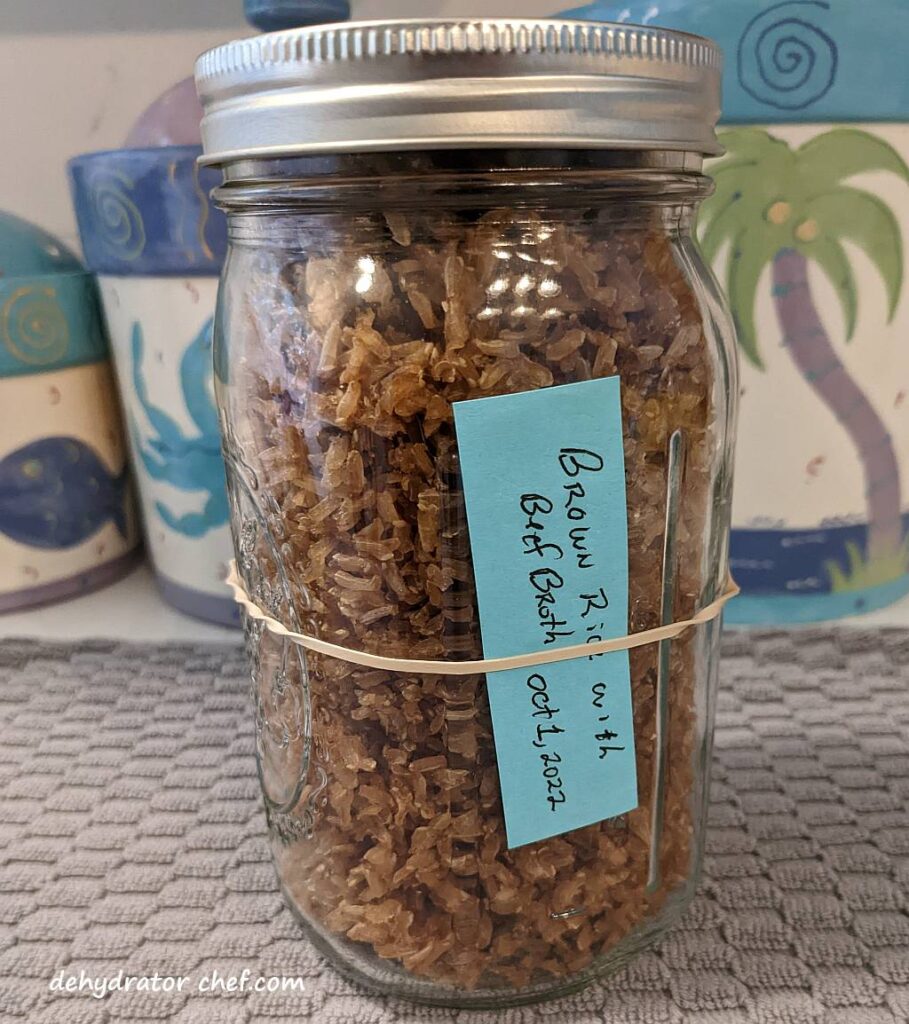
We’ll use a food-safe desiccant packet for moisture control because we live in a fairly humid area. For our pint-size or quart-size mason jars, we’ll use a single food-safe 5-gram desiccant packet.
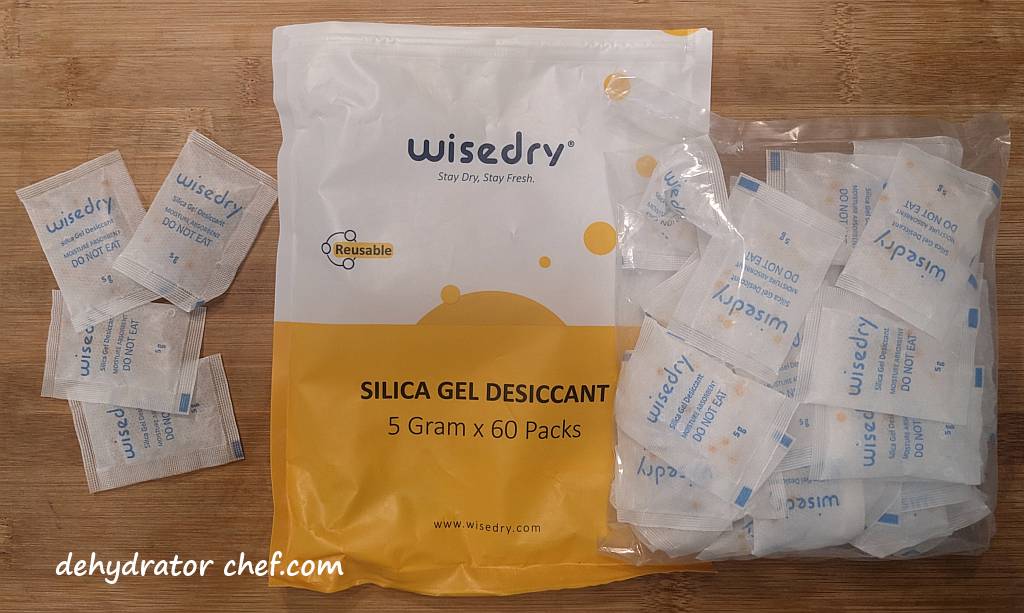
We use these inexpensive food-safe desiccant packets, which are available from Amazon. These 5-gram packets have over 5000 of mostly 4- and 5-star customer reviews, with an average of 4.7 stars out of 5. Our bag of 60 desiccant packets will last quite a while because they can be recharged and reused multiple times. Other food-safe sizes are available.
Dehydrated brown rice doesn’t really last long around here. Mostly because I dehydrate and store foods that we normally eat every day or I’m stocking up for a camping trip.
Lastly, I’ll attach or include a short note describing the jar contents and the date the product was dehydrated. The note also lets me know where to go in my dehydrator logbook if I want to make another note or two.
Hydration
Hydrate the dried brown rice using a 1-to-1 ratio of dehydrated rice to boiled water. Plan on at least 15 to 20 minutes to fully hydrate.
If you’re supplementing store-bought freeze-dried meals as we do, just add a bit more boiling water to the food pouch. Use the same 1-to-1 ratio of dehydrated brown rice to water and account for the extra time.
Weights, Measures, and Serving Sizes
This information is summarized from the notes we keep in our logbook for most of our food dehydration efforts.
The one cup of cooked brown rice cooked as described above, weighs approximately 190 grams.
When dehydrated, the same 1 cup of cooked rice now weighs approximately 50 grams. The 50 grams of dehydrated brown rice is approximately 1/2 cup.
Dehydrated Brown Rice Nutrition Information
Nutrition information is only an estimate. The nutrition information may differ depending on the ingredients you use.
Serving Size: 50 grams | Calories: 225kcal | Total Fat: 2g | Saturated Fat: 0g | Cholesterol: 0mg | Sodium: 0mg | Carbohydrate: 45g | Dietary Fiber: 2g | Sugar: 0g | Protein: 4g
 | The Dehydrator Chef Book Available only on Amazon.com You’ll find step-by-step instructions for 26 homemade dehydrated camping meals. Many recipes are only available in this book. Grab yourself a copy today. |
Insider Tips
Dehydrated brown rice is a multi-tasker. Besides dehydrated meal recipes here, add dehydrated brown rice to any of your favorite freeze-dried food pouches. Be sure to compensate by adding additional just boiled water in a 1-to-1 ratio and allow enough time for adequate hydration. Dehydrated brown rice takes about 20 minutes to hydrate so it’s not too chewy.
Practice at home making dehydrated camping meals using the very same gear used in the field. We practice to reinforce the skills we have learned. Practice makes perfect.
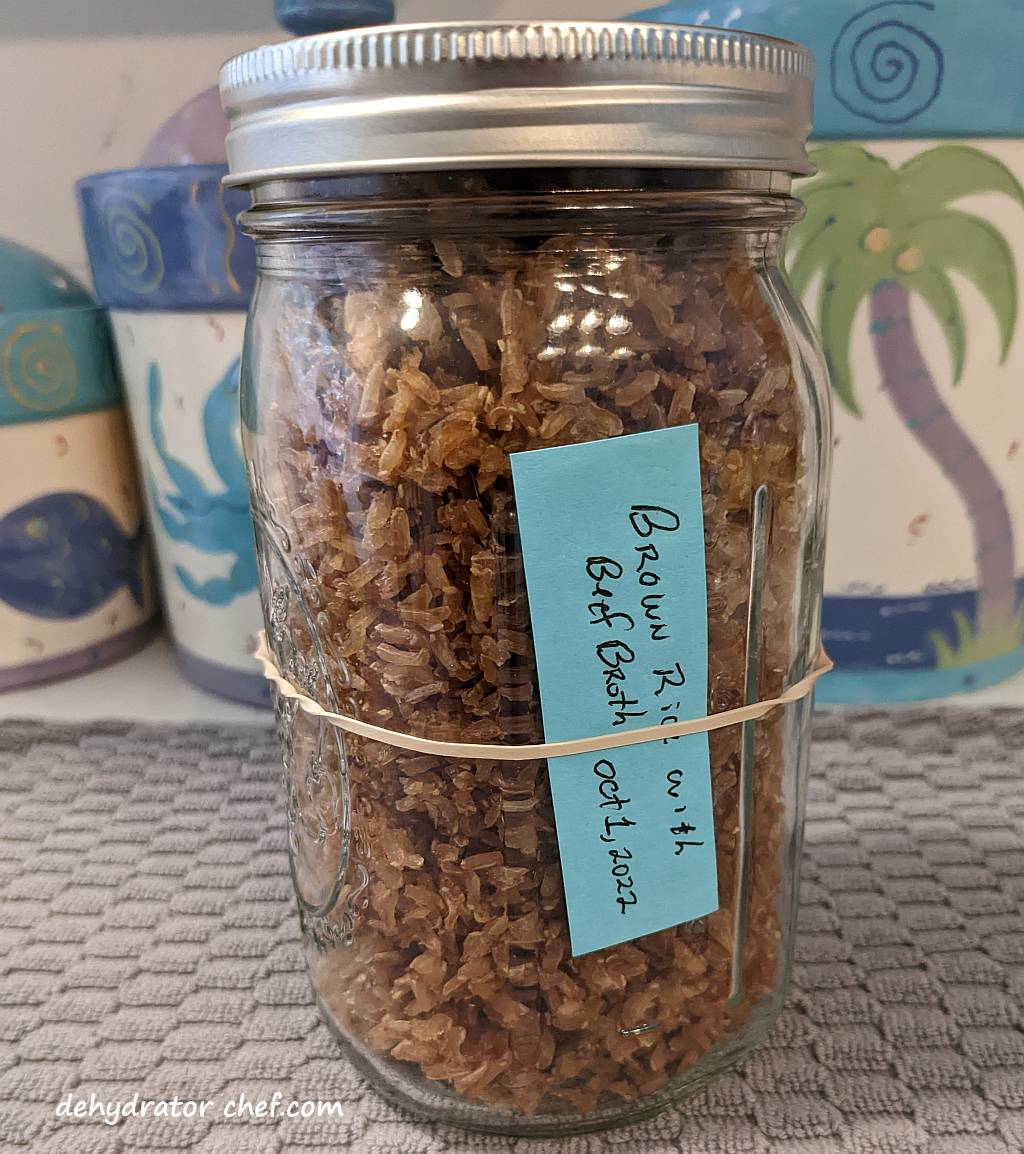
How to Dehydrate Brown Rice
Equipment
- Removable fruit roll sheet insert (one for each dehydrator tray)
- Common kitchen tools (including cutting boards, chef's knife, spatula, strainer, etc.)
- Canning jars with tight-fitting lids
- Desiccant packets for moisture control (optional)
Ingredients
- 16 ounces brown rice
Instructions
Process the Brown Rice
- Using a wire mesh strainer, rinse the brown rice to remove surface starch.16 ounces brown rice
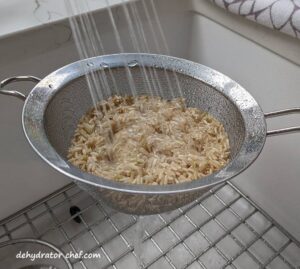
- Inspect the rice as you rinse it, removing anything that shouldn't be there. Despite the use of modern cleaning equipment, it is not always possible to remove all foreign materials.
- Cook the rice according to package directions; omit any added oils or fats.
Prepare the Dehydrator
- Spread and layer the processed cooked brown rice on the fruit roll sheet inserts; one cup of rice will fill one 13.5-inch round dehydrator tray. If it’s too crowded, prepare another tray.

Dehydrate the Brown Rice
- Set the dehydrator thermostat temperature to 135 °F (57 °C). Dry for 18 to 24 hours until done.
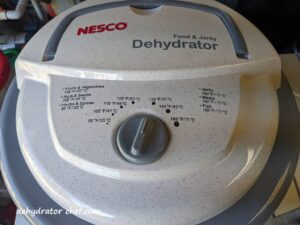
- Check on the rice every few hours and break apart the bigger pieces into smaller fragments to help prevent case hardening.
When is the Dehydrated Brown Rice Done
- When done, the rice fragments should easily separate into individual rice kernels. There should be no wet or mushy areas.
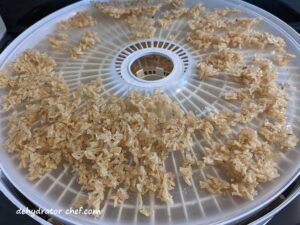
Equalizing and Conditioning the Dehydrated Brown Rice
- After a short cooling period, loosely pack the dried rice into a clean, dry canning jar with a tight-fitting lid, leaving some headspace.
- Every day, for 7 to 10 days, check the jar for moisture. Roll the jar contents around and note any clumping or sticking. If seen, put it all back on the dehydrator for several more hours.
- If you notice any mold at all, even the slightest bit, throw it all out.
Storing the Dehydrated Brown Rice
- Use appropriate-sized canning jars for storage. Brown rice, due to the bran oil in it, will keep for several months, depending on how well you dehydrate it and your pantry storage conditions.
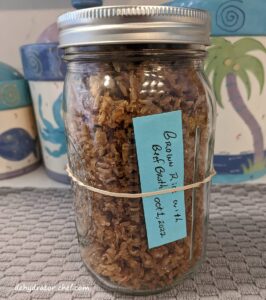
- An optional food-safe desiccant packet will aid with moisture control and enable a longer shelf life

- Attach or include a label describing the jar contents and the date the product was dehydrated. The label identifies the canning jar contents, and the date helps with the rotation schedule. A first-in, first-out rotation helps us to use items that have been on the shelf the longest, so we're using the oldest food first.
Notes
Nutrition
Nutrition information is only an estimate and may differ depending on the ingredients you use.
